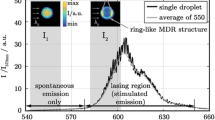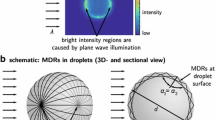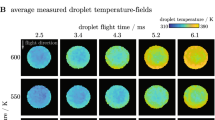Abstract
This work presents “pulsed 2D-3cLIF-EET” as a measurement setup for micro-droplet internal temperature imaging. The setup relies on a third color channel that allows correcting spatially changing energy transfer rates between the two applied fluorescent dyes. First measurement results are compared with results of two slightly different versions of the recent “pulsed 2D-2cLIF-EET” method. Results reveal a higher temperature measurement accuracy of the recent 2cLIF setup. Average droplet temperature is determined by the 2cLIF setup with an uncertainty of less than 1 K and a spatial deviation of about 3.7 K. The new 3cLIF approach would become competitive, if the existing droplet size dependency is anticipated by an additional calibration and if the processing algorithm includes spatial measurement errors more appropriately.









Similar content being viewed by others
Notes
Assuming a pulse duration of 4 ns and a droplet velocity of 20 m/s cause a negligible motion blur of 0.08 \(\upmu\)m, far less than the typically available optical resolution.
Fluorescence saturation describes the loss of linearity between the fluorescence signal and its excitation intensity (Chaze et al. 2016).
Self-absorption needs to be differentiated from re-absorption. While the latter case concerns interaction of two dyes, the first case considers the overlap of the emission and absorption spectrum of a single dye.
The droplet velocity is the product of the measured droplet distance and the known droplet-generation frequency.
Using dry air allows prevention of water condensation on the droplet surface.
For a 100 mum droplet, a dye concentration of 5 μM and a molar attenuation coefficient of 2 × 104 L/mol/cm (at 550 nm, compare Fig. 1c), self-absorption is estimated using the Beer–Lambert law to approximately 0.001 %.
The repetition rate is limited by the fluorescence detector.
This values is an average value. For high temperature, average received fluorescence signal intensity reduced and the noise increases slightly.
References
Armstrong RL, Xie JG, Ruekgauer TE, Pinnick RG (1992) Energy-transfer-assisted lasing from microdroplets seeded with fluorescent sol. Opt Lett 17(13):943. https://doi.org/10.1364/OL.17.000943
Arnold S, Folan LM (1986) Fluorescence spectrometer for a single electrodynamically levitated microparticle. Rev Sci Instrum 57(9):2250–2253. https://doi.org/10.1063/1.1138693
Arnold S, Folan LM (1989) Energy transfer and the photon lifetime within an aerosol particle. Opt Lett 14(8):387. https://doi.org/10.1364/OL.14.000387
Bruchhausen M, Guillard F, Lemoine F (2005) Instantaneous measurement of two-dimensional temperature distributions by means of two-color planar laser induced fluorescence (PLIF). Exp Fluids 38(1):123–131. https://doi.org/10.1007/s00348-004-0911-2
Castanet G, Lavieille P, Lebouché M, Lemoine F (2003) Measurement of the temperature distribution within monodisperse combusting droplets in linear streams using two-color laser-induced fluorescence. Exp Fluids 35(6):563–571. https://doi.org/10.1007/s00348-003-0702-1
Castanet G, Delconte A, Lemoine F, Mees L, Gréhan G (2005) Evaluation of temperature gradients within combusting droplets in linear stream using two colors laser-induced fluorescence. Exp Fluids 39(2):431–440. https://doi.org/10.1007/s00348-005-0931-6
Castanet G, Frackowiak B, Tropea C, Lemoine F (2011) Heat convection within evaporating droplets in strong aerodynamic interactions. Int J Heat Mass Transf 54(15–16):3267–3276. https://doi.org/10.1016/j.ijheatmasstransfer.2011.03.060
Chang RK, Campillo AJ (eds) (1996) Optical processes in microcavities, advanced series in applied physics, vol 3. World Scientific, Singapore. https://doi.org/10.1142/ASAP
Chaze W, Caballina O, Castanet G, Lemoine F (2016) The saturation of the fluorescence and its consequences for laser-induced fluorescence thermometry in liquid flows. Exp Fluids. https://doi.org/10.1007/s00348-016-2142-8
Chaze W, Caballina O, Castanet G, Lemoine F (2017) Spatially and temporally resolved measurements of the temperature inside droplets impinging on a hot solid surface. Exp Fluids 58(8):2579. https://doi.org/10.1007/s00348-017-2375-1
Chen G, Mohiuddin Mazumder M, Chang RK, Christian Swindal J, Acker WP (1996) Laser diagnostics for droplet characterization: Application of morphology dependent resonances. Prog Energy Combust Sci 22(2):163–188. https://doi.org/10.1016/0360-1285(96)00003-2
Crimaldi JP (2008) Planar laser induced fluorescence in aqueous flows. Exp Fluids 44(6):851–863. https://doi.org/10.1007/s00348-008-0496-2
Deprédurand V, Miron P, Labergue A, Wolff M, Castanet G, Lemoine F (2008) A temperature-sensitive tracer suitable for two-colour laser-induced fluorescence thermometry applied to evaporating fuel droplets. Meas Sci Technol. https://doi.org/10.1088/0957-0233/19/10/105403
Deprédurand V, Delconte A, Lemoine F (2011) Combined PDA and LIF applied to size-temperature correlations measurements in a heated spray. Exp Fluids 50(3):561–571. https://doi.org/10.1007/s00348-010-0956-3
Druger SD, Arnold S, Folan LM (1987) Theory of enhanced energy transfer between molecules embedded in spherical dielectric particles. J Chem Phys 87(5):2649. https://doi.org/10.1063/1.453103
Folan LM, Arnold S, Druger SD (1985) Enhanced energy transfer within a microparticle. Chem Phys Lett 118(3):322–327. https://doi.org/10.1016/0009-2614(85)85324-0
Frackowiak B, Tropea C (2010) Numerical analysis of diameter influence on droplet fluorescence. Appl Opt 49(12):2363–2370. https://doi.org/10.1364/AO.49.002363
Hidrovo CH, Hart DP (2001) Emission reabsorption laser induced fluorescence (ERLIF) film thickness measurement. Meas Sci Technol 12(4):467–477. https://doi.org/10.1088/0957-0233/12/4/310
Labergue A, Deprédurand V, Delconte A, Castanet G, Lemoine F (2010) New insight into two-color LIF thermometry applied to temperature measurements of droplets. Exp Fluids 49(2):547–556. https://doi.org/10.1007/s00348-010-0828-x
Labergue A, Delconte A, Castanet G, Lemoine F (2012) Study of the droplet size effect coupled with the laser light scattering in sprays for two-color LIF thermometry measurements. Exp Fluids 52(5):1121–1132. https://doi.org/10.1007/s00348-011-1242-8
Labergue A, Delconte A, Lemoine F (2013) Study of the thermal mixing between two non-isothermal sprays using combined three-color LIF thermometry and phase doppler analyzer. Exp Fluids. https://doi.org/10.1007/s00348-013-1527-1
Lavieille P, Delconte A, Blondel D, Lebouché M, Lemoine F (2004) Non-intrusive temperature measurements using three-color laser-induced fluorescence. Exp Fluids 36(5):706–716. https://doi.org/10.1007/s00348-003-0748-0
Lemoine F, Wolff M, Lebouché M (1996) Simultaneous concentration and velocity measurements using combined laser-induced fluorescence and laser doppler velocimetry: application to turbulent transport. Exp Fluids 20(5):319–327. https://doi.org/10.1007/BF00191013
Lemoine F, Antoine Y, Wolff M, Lebouche M (1999) Simultaneous temperature and 2d velocity measurements in a turbulent heated jet using combined laser-induced fluorescence and LDA. Exp Fluids 26(4):315–323. https://doi.org/10.1007/s003480050294
Palmer J, Mathieu F, Reddemann MA, Kneer R (2014) Temperature measurements of evaporating biofuel droplets. In: ILASS Europe 2014, 26th annual conference on liquid atomization and spray systems, Bremen
Palmer J, Reddemann MA, Kirsch V, Kneer R (2016) Temperature measurements of micro-droplets using pulsed 2-color laser-induced fluorescence with MDR-enhanced energy transfer. Exp Fluids. https://doi.org/10.1007/s00348-016-2253-2
Palmer J, Reddemann M, Kirsch V, Kneer R (2017) Development steps of 2-color laser-induced fluorescence with MDR-enhanced energy transfer for instantaneous planar temperature measurement of micro-droplets and sprays. In: Proceedings ILASS–Europe 2017, 28th European conference on liquid atomization and spray systems, Valencia, Spain. https://doi.org/10.4995/ILASS2017.2017.4591
Palmer J, Reddemann MA, Kirsch V, Kneer R (2018) Applying 2d-2cLIF-EET thermometry for micro-droplet internal temperature imaging. Exp Fluids. https://doi.org/10.1007/s00348-018-2506-3
Perrin L, Castanet G, Lemoine F (2015) Characterization of the evaporation of interacting droplets using combined optical techniques. Exp Fluids. https://doi.org/10.1007/s00348-015-1900-3
Tzeng HM, Wall KF, Long MB, Chang RK (1984) Laser emission from individual droplets at wavelengths corresponding to morphology-dependent resonances. Opt Lett 9(11):499. https://doi.org/10.1364/OL.9.000499
Acknowledgements
This work was performed as part of the Cluster of Excellence “Tailor-Made Fuels from Biomass”, which is funded by the Excellence Initiative of the German federal and state governments to promote science and research at German universities.
Author information
Authors and Affiliations
Corresponding author
Additional information
Publisher's Note
Publisher's Note Springer Nature remains neutral with regard to jurisdictional claims in published maps and institutional affiliations.
Rights and permissions
About this article
Cite this article
Palmer, J., Reddemann, M.A., Kirsch, V. et al. Comparison of 2c- and 3cLIF droplet temperature imaging. Exp Fluids 59, 102 (2018). https://doi.org/10.1007/s00348-018-2545-9
Received:
Revised:
Accepted:
Published:
DOI: https://doi.org/10.1007/s00348-018-2545-9




